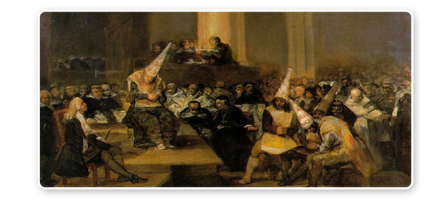
The Inquisition in Córdoba (2 o2) Audiodescription.

The Spanish Inquisition was established in 1482 by a papal bull passed by Pope Sixtus IV during the reign of the Catholic Monarchs. The Inquisition was originally intended in large part to ensure the orthodoxy of those who converted from Judaism and Islam.
The Spanish Inquisition depended directly on the Spanish monarchy in contrast to the medieval inquisition. It was established in all of the kingdoms of Spain, Sardinia and Sicily, since they belonged to the Kingdom of Aragon. After the discovery of America, the inquisition was also established in Mexico, South America and Peru. The Spanish Inquisition, along with the monarchy, was the only common institution between the different kingdoms of Spain, and it was often used to reinforce the royal power.
This palace was turned into a dark and sinister place when it was transferred to the Tribunal of the Holy Office of the Inquisition the by the Catholic Monarchs, becoming the base of this ecclesiastical court. Because of the new needs of the institution, the Alcazar was turned into a prison with cells and offices for the employees, losing the harmony and magnificence which it had enjoyed as a royal residence.
The acts carried out under priest Diego Rodriguez Lucero of Moguer (Huelva) are an example of the excesses of the Inquisition. He was appointed inquisitor in 1499 and sentenced over 200 people to death in only 4 years. The auto-da-fé held on 22th December 1504 on the site of the current Corredera square was especially bloody: 107 persons were burnt at the stake, accused of being false converted Jews. The cordoban people, angry with this outrageous man, assaulted the Alcazar on 9th November 1505 to free over 400 prisoners. The inquisitor, afraid of the popular rage, fled through a back door of the Alcazar to save his life. He and his cruelty are remembered by Cordoban history to this day.
Sections of this piece:
Press the Play buttons to access a speech version of the description or the audiodescription for visually impaired.
Click in Audiodescription to access to its text version.

Alcazar of the Christian Monarchs. Plaza Campo Santo de los Mártires s/n. 14004 Córdoba
2011 Ayto. de Córdoba. All rights reserved. Legal Advice


